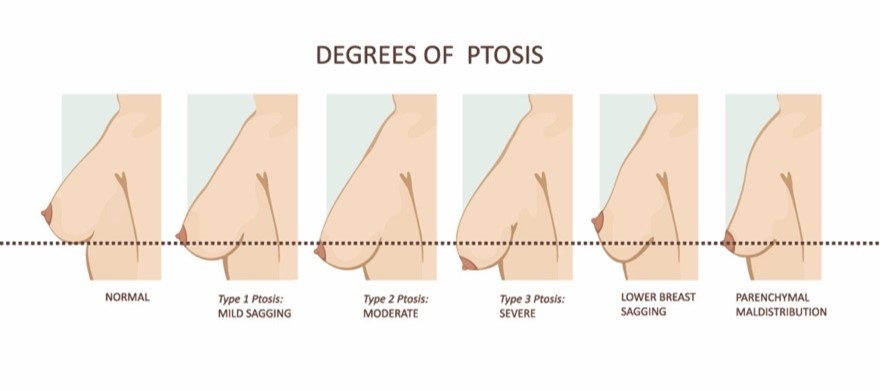Breast ptosis (drooping) happens when the structures supporting the breast tissues fail and often occurs with natural aging, pregnancy, breastfeeding, or overly large breasts. There are several degrees and variations of breast ptosis based on the relation of the nipple and breast tissue to the crease under the breast. Charles S. Lee, MD, offers breast lift and will tailor his surgical approach to your needs based on the severity of your drooping breasts.
Breast lift elevates and reshapes the breast tissues for higher positioning on the chest wall and improved firmness. The procedure can reduce enlarged areolas and may relocate the nipple-areolar complex for the best results.
Types of Breast Ptosis
The normal nipple position on the breasts is about five to seven centimeters above the natural breast crease (inframammary fold). Ptosis starts when the nipple measures less than two centimeters above the crease and the positioning of the breast and abdominal wall is less than a 90-degree angle.
Grade 1
First-degree breast ptosis is mild sagging where the nipple is found within one centimeter of the inframammary fold, causing the breasts to droop over the crease. The nipple may still point outward. Dr. Lee may recommend correcting mild ptosis with the crescent breast lift. This technique makes a tiny incision in the top of the areola to tighten the tissues. The peri-areolar or “donut” lift is another approach and involves two circular incisions in the shape of a donut around the areolas. The crescent and donut breast lifts can be combined with breast augmentation to increase breast size and upper-pole fullness.
Grade 2
Second-degree breast ptosis is moderate breast drooping where the nipple falls one to three centimeters under the inframammary fold. The nipples may point outward or downward. Dr. Lee may recommend the donut breast lift for moderate sagging or the lollipop lift. The vertical breast lift uses the same circular incisions as the donut method and adds another incision from the bottom edge of the areola down to the breast crease, forming a lollipop shape.
Grade 3
Third-degree breast ptosis is considered severe and happens when the nipples point down to the ground and extend over three centimeters under the breast crease. Severe breast drooping may also cause the upper portion of the breast to sit below the crease. Dr. Lee may recommend the inverted T breast lift or anchor lift. This surgical approach uses the same incisions as the lollipop lift and adds a third one along the inframammary fold. The anchor approach allows for optimal breast reshaping and maximum skin removal and may relocate the nipple-areolar complex to a higher position on the breast.
Pseudoptosis
Pseudoptosis happens when the breast tissue sinks below the natural breast crease, but the nipple location remains above the fold. This is also called lower breast sagging and requires a customized approach for breast lift.
Parenchymal Maldistribution
This type of ptosis happens when the breasts are an unusual shape. Parenchymal maldistribution causes the breast to form a hollow scoop when the tissue is lifted and requires a combination of breast augmentation and breast lift to restore a natural breast appearance and position. It’s also called lower-pole hypoplasia and is similar to tubular breasts.
If you’re interested in breast lift for breast ptosis, contact our double board-certified plastic surgeon in Beverly Hills. Schedule a consultation with Dr. Lee at Enhance® Medical Center by calling (310) 271-5954.









